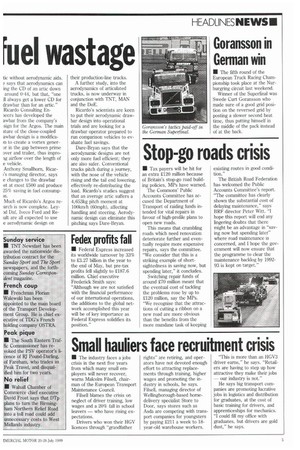Fuel wastage
Page 7

If you've noticed an error in this article please click here to report it so we can fix it.
tic without aerodynamic aids.
says that aerodynamics can ing the CD of an artic down around 0.44, but that, "one II always get a lower CD for drawbar than for an artic." Ricardo Consulting Enleers has developed the awbar from the company's .sign for the Argos. The main ature of the close-coupled awbar design is a modificain to create a vortex generor in the gap between prime aver and trailer, thus impro1g airflow over the length of e vehicle.
Anthony Smallhorn, Ricari's managing director, says e changes to the drawbar ,st at most £500 and produce 25% saving in fuel consumpm.
Much of Ricardo's Argos re:arch is now complete. Ley Daf, Iveco Ford and Reath are all expected to use e aerodynamic design on their production-line trucks. A further study, into the aerodynamics of articulated trucks, is now underway in conjunction with TNT, MAN and the DoE.
Ricardo's scientists are keen to put their aerodynamic drawbar design into operational trials and are looking for a drawbar operator prepared to run comparison vehicles to evaluate fuel savings.
Dare-Bryan says that the aerodynamic designs are not only more fuel efficient; they are also safer. Conventional trucks pitch during a ,journey, with the nose of the vehicle rising and the tail end lowering, effectively re-distributing the load. Ricardo's studies suggest that an average artic suffers a 4,653kg pitch moment at 1001(m/h (60mph), affecting handling and steering. Aerodynamic design can eliminate this pitching says Dare-Bryan.








































































































































